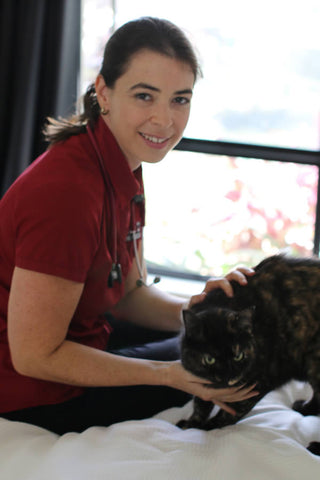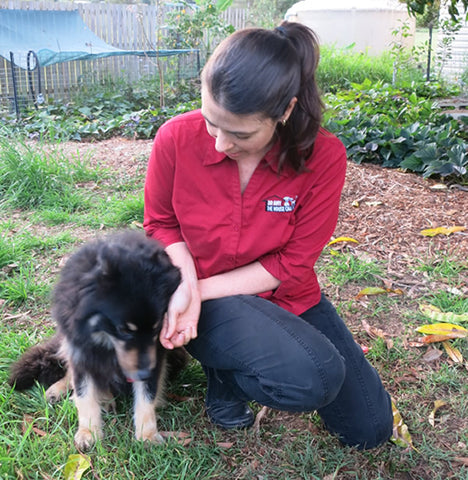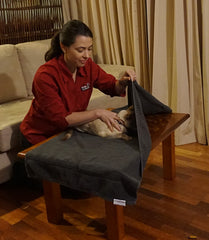Low Stress Handling Part 4 - veterinarian behaviour September 9, 2015 14:27
I've been looking forward to writing this blog post - I get to explain the deliberation behind my sometimes strange behaviour! I'm not just a wierdo after all :-D

You know how cats can always tell if a visitor is "not a cat person" and they always go and rub against them, or sit on them? It turns out that they aren't just deviously exacting revenge for lack of enthusiasm for the feline species. They are actually misinterpreting human body language.
Why do I tell you this? Because I personally do a lot of things aimed specifically at your pet reading my body language and feeling comfortable around me. But this body language is different to human body language, so what I'm doing might not send owners the same message. I'll give you a few examples, and you'll see what I mean.
When I first arrive, I will often ignore my patients. This might make you think I don't like them, or am not interested in them. Nothing could be more wrong! However I am communicating to them in their own language. What I am saying is: "I'm not confrontational, I won't challenge you for your territory or food, and I won't attack you. I am not a threat." If a new arrival looked directly into a dog or cats eyes, this would be very upsetting for most of them. And if I walked straight up to them, they could become worried, expecting a confrontation.

Instead I focus on the owners and chat for a while. I often put my housecalling box down and step away from it, which invites pets to approach and investigate. If possible, I will sit down and make myself comfortable. Sorry! I'm not meaning to be overfamiliar in your home. I am working at putting your pet at ease. Please feel relaxed and sit down with me and let your pets do their thing for a while.
When dogs are timid, I will often approach them sideways. It looks funny I know, but it really helps. I will offer them treats - thrown to them if they aren't ready to approach me. Held out behind my back if they are comfortable with that, or sideways if they are good with that position. And I may conduct my examination surreptitiously from these sideward positions. You may not even realise I've done some of it, because I will probably keep chatting away for a lot of the time, and do little bits of examination intermittently in between discussing your worming regime, my pets, your job, holiday plans and the weather.

I may offer treats throughout the process. If I have to give an injection, I will often ask you to give treats while I am doing so. This is more than just distraction. It is a training technique called classical conditioning where we pair something positive with the vet visit and injection. In the pet's memory, the positive emotional state induced by the reward becomes connected with the other experience (eg. the needle) because they happen simultaneously. So I often tell people that their pet needs to lose weight, then feed them a ton of treats. But they remember me as the liver treat lady, and hope for my return. It's worth it just this once! Then back on the diet.
I don't always pat pets a great deal. Many pets (especially cats, but also some timid dogs) actually prefer not to be patted - and I am purely concentrating on keeping them as relaxed and confident as possible. If you think about your friends and acquaintances, I'm sure you can think of people who prefer not to be hugged and kissed. There are natural differences in how we receive affection and I try to adjust my behaviour to suit each patient. I can't tell till I try though. So you might see me do a little quick pat and then stop. This would happen if your pet exhibited subtle signs of anxiety when I patted them. If they responded happily, then I would have continued. Food, play, pats, and verbal praise are all rewards that I will try out on most pets to assess their response. What they respond to when you're home alone with them may not be the same as what they respond to from me. Imagine if, at the beginning of your consultation, your doctor gave you a big squishy hug and kiss like your grandma does. It might freak you out!
A paragraph specifically about cats. They are different to dogs. I'm sure you've noticed too! One thing that they sometimes need is a hiding place. However I can't let them just actually go and hide from me. So what works in some cases is to wrap them up in a towel. This has been shown to decrease the stress levels for many cats in fearful situations. Depending on what I am needing to do to a cat, there are different ways to wrap them. Some people are taken aback by the wrapping, but it's only ever done to make the cat feel more secure and comfortable. And yes, they can still breathe! Cats only take tiny breathes. I'm sure many of my cat patients sleep at the bottom of the bed, entirely under the thick blankets and quilt for the whole night. You or I would run out of air down there. They don't.


Another thing about cats - they have a limited tolerance time. So I like to get everything out and ready, and be sure I've got it all prepared before I approach the cat at all. Then it's time for prioritising and efficiency without hustle or rush. Once a cat starts getting annoyed and resenting the intrusion, my time is up!
My house call visits are almost always longer than the typical 15 minutes allotted time in a vet surgery. What I am trying to achieve often simply cannot be done in that time frame. Sometimes, I may suggest that the checkup and treatment be spread out over two visits. This can be helpful if pets don't know me yet and are exhibiting a lot of anxiety. By taking it slowly the first visit, they cope, and remember that it was ok last time, so the next time I come we start a little further ahead in our trust relationship. Not every owner is open to that suggestion, as it does mean paying another visit fee, however I have found it very useful in some cases.

Finally, a quick word about the excitable dogs. A dog in a state of high excitement is just as difficult to examine and treat as a dog who is fearful. So if your dog is super bouncy and gets "hyper" really easily, I will talk and move slowly, keep play to a minimum and try to be generally boring. A thorough examination is more likely to be possible this way. Usually these ones enjoy any attention and touch, so they still enjoy what I do without the need for me to be the most exciting thing that happened all month!
I hope you've enjoyed this peak at the reasons behind some of my actions. Now you're all going to be watching me when I'm at your place next, seeing if you can pick out which of these things I'm doing with your pet!
Dr Amy Coles
